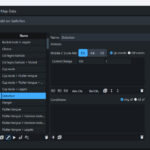Guitar tablature, affectionately known as “guitar tabs,” is a revolutionary system for writing down music that allows aspiring guitarists to dive into playing songs quickly and easily. While sharing some common ground with traditional music notation by indicating notes, rhythm, and playing techniques, guitar tabs offer a significant advantage, especially for beginners: they visually represent where to play those notes directly on the guitar.
This is incredibly helpful because the guitar fretboard offers multiple locations to play the same note. Understanding and learning how to read guitar tabs unlocks the door to playing guitar without the initial hurdle of mastering standard musical notation. For beginners, guitar tabs are often the most accessible and fastest way to start learning your favorite songs. They bypass the complexities of traditional notation, requiring only a basic understanding of your guitar’s strings and frets.
At guitarplayers.net, we believe in empowering musicians of all levels. That’s why we’re dedicated to helping you understand how to read guitar tablature. Whether you want to learn chords or single notes, guitar tabs are the ideal tool to learn quickly and efficiently. If you’re eager to discover what guitar tabs are and how they can accelerate your guitar journey, you’re in the perfect place. Let’s explore the world of guitar tabs together.
DECODING GUITAR TABS: A Visual Guide
Guitar tablature presents music visually through a series of lines and numbers. A standard guitar tab uses six horizontal lines, each representing one of the six strings of a guitar. When you read guitar tabs, you interpret them from top to bottom. The topmost line corresponds to the high E string (the thinnest string), followed by lines for the B, G, D, A, and low E strings (the thickest string).
Think of guitar tablature as a direct map of your guitar neck as you look down at it while playing. This visual representation makes guitar tabs an invaluable tool, offering a straightforward path to learning guitar songs efficiently.
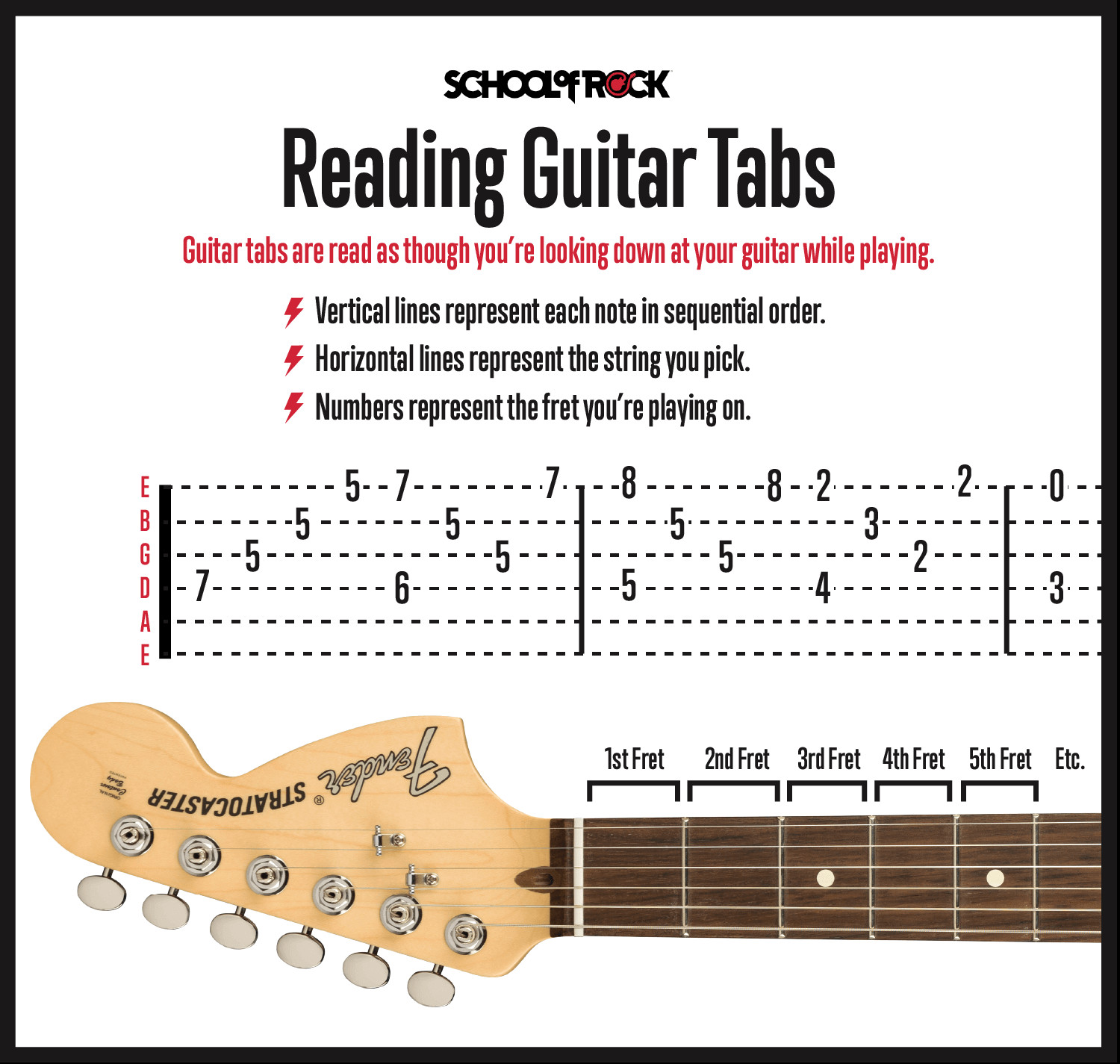 Reading guitar tabs
Reading guitar tabs
Understanding guitar tablature layout with string representation and fret numbers.
Within the guitar tab, you’ll notice numbers placed on these lines. These numbers indicate the fret to be played on the corresponding string. Frets are the metal bars along the guitar’s fretboard, numbered 0-24, starting from the nut (closest to the headstock) and extending down the neck.
A ‘0’ on a string means you play that string “open,” without pressing down on any fret with your fretting hand. A ‘1’ signifies playing at the first fret, ‘2’ at the second fret, and so on. Mastering how to read guitar tabs involves understanding this simple numerical fret system: each number directly correlates to a fret position.
To further illustrate, consider this: Imagine a ‘3’ on the line representing the G string. This tells you to press down the G string at the 3rd fret and pluck or pick that string. It’s as simple as following the numbers to find your notes.
STEP-BY-STEP GUIDE: Reading Guitar Tabs
Guitar tablature is read from left to right, just like standard written language. The sequence of notes in a tab is chronological, indicating the order in which they are played in a song. When you see numbers stacked vertically in a column across multiple lines, this indicates a chord. A chord is played by strumming all the strings indicated in that vertical column simultaneously. Guitar tab notation excels for beginners because it clearly shows both the notes within a chord and their precise location on the guitar neck, making chord learning much more intuitive than standard notation alone.
Essential Knowledge for Reading Guitar Tabs
To effectively read guitar tabs, beginners should first become acquainted with the names of the 6 guitar strings (E, B, G, D, A, E from thinnest to thickest) and the layout of the frets on their guitar. This fundamental knowledge allows you to translate the numbers and lines in a tab into actual finger positions on your instrument, enabling you to play the intended notes accurately.
GUITAR TAB STAFF: Strings, Not Notes
The guitar tab staff visually resembles the staff used in standard musical notation, but with a crucial difference. Instead of representing musical pitches directly, the lines in a guitar tab staff represent the six guitar strings.
The top line is always the high E string, and the bottom line is always the low E string. This direct string-to-line correspondence greatly simplifies learning how to read guitar tabs, especially for visual learners. Typically, you will also see “TAB” clearly labeled at the beginning of the staff to distinguish it from standard notation.
UNDERSTANDING GUITAR FRETS: The Building Blocks of Notes
Guitar frets are the thin metal strips that are embedded across the fretboard of your guitar. They are essential for changing the pitch of a string when pressed down.
Most guitars feature between 19 and 24 frets. The distance between each consecutive fret represents one semitone, or half step, in musical terms. Within each octave, there are 12 semitones (or frets). To help navigate the fretboard, most guitars include fret markers, often dots or inlays, typically positioned at the 3rd, 5th, 7th, 9th, and 12th frets. These markers serve as visual landmarks, making it easier to locate positions quickly while playing.
Remember the number ‘0’ in guitar tabs? It always signifies an open string. When you see a ‘0’, you simply pluck or pick the string without fretting any note, allowing it to ring at its natural open pitch. Any number greater than ‘0’ indicates the fret number to be used on that string.
GUITAR TAB CHORDS: Vertical Harmony
Guitar chords in tablature don’t have dedicated symbols but are easily recognizable by their arrangement. When multiple numbers are aligned vertically in a tab, they represent a chord, indicating that these notes should be played together simultaneously. Even if a chord is arpeggiated (played one note at a time), in tab, it will appear as a sequence of single notes, even though you are still holding down the chord shape.
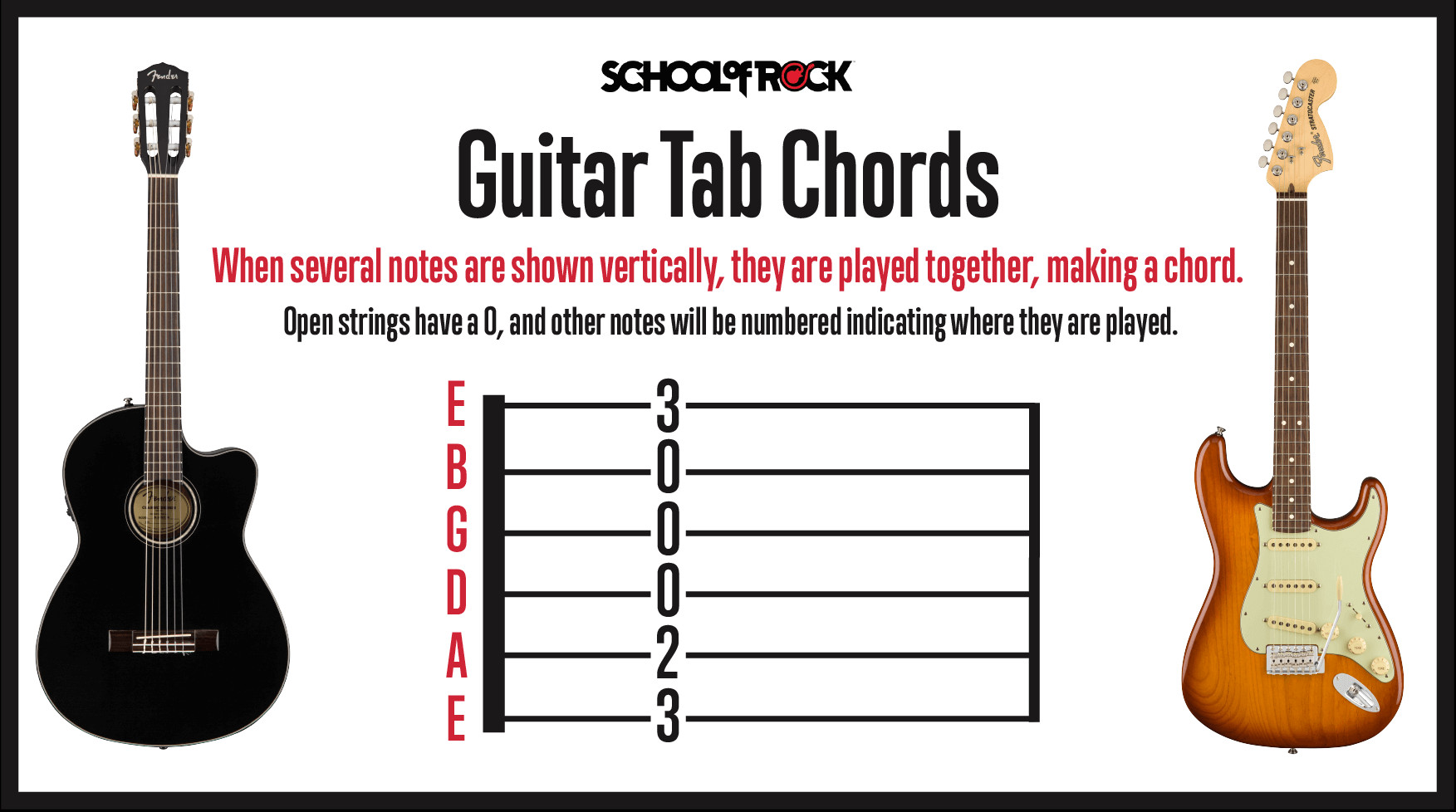 How to read guitar tab chords
How to read guitar tab chords
Visual representation of a chord in guitar tablature, showing vertical alignment of notes.
GUITAR TAB RIFFS: The Soul of Rock and More
Riffs, the catchy and often repeated musical phrases, are the backbone of many genres, especially Rock. Guitar tabs handle riffs effectively, usually presenting them as a mix of single notes and partial chords, like power chords. The same rule applies: vertical alignment of notes means they are played together. This clarity makes learning riffs from guitar tablature straightforward.
GUITAR TABS VS. CHORD CHARTS: Different Tools for Different Needs
While both are helpful for guitarists, guitar tabs and chord charts serve different purposes. A chord chart is a visual diagram showing you where to place your fingers on the fretboard to form a specific chord, often including finger numbers. Chord charts are frequently placed above song lyrics to indicate chord changes.
However, chord charts are limited; they typically only show the root chord notes. A full song arrangement might include single notes, notes outside the basic chord, or arpeggios, which chord charts alone don’t display. Guitar tabs often incorporate chord charts to bridge this gap, helping beginners grasp basic chord shapes while also providing the detailed musical information needed to play a song accurately.
FINGERS AND NUMBERS: Clarifying the Notation
Chord charts and guitar tabs use numbers, but for different things. Chord charts use numbers to indicate which finger to use (1=index, 2=middle, 3=ring, 4=pinky). Guitar tabs, conversely, use numbers to denote fret numbers, not fingerings. For this reason, combining chord charts with beginner guitar tabs is a useful approach, as chord charts can guide hand positioning while tabs show the precise musical notes and timing.
Unleash Your Guitar Skills: Performance Ready
Our expert-led music programs are designed by experienced, practicing musicians dedicated to helping you learn to play. Gain real-world performance experience and hone your guitar skills in a supportive environment for all skill levels.
UNLOCKING GUITAR TAB SYMBOLS: Beyond the Basics
Beyond lines and numbers, guitar tabs use a variety of symbols to indicate specific playing techniques. Learning these symbols is crucial for playing with authenticity and expression.
Before diving into techniques, always ensure your guitar is properly tuned. Tuning is the foundation of good sound.
MUTING GUITAR NOTES: Adding Depth and Dynamics
Muting is a vital technique in many guitar styles, particularly in genres like Heavy Metal, Punk, and Alternative. Muting adds rhythmic and tonal variation, creating a more dynamic and polished sound.
MASTERING GUITAR MUTES
Muting can be achieved using either your picking hand or your fretting hand, or sometimes both. It’s a technique that many guitarists use instinctively to control unwanted string noise, especially at higher volumes, preventing muddiness or feedback. In song arrangements, muting might be used in verses for contrast with a more open, ringing chorus.
GUITAR TECHNIQUE: PALM MUTING – The Rock Staple
Palm muting is extremely common in rock guitar. It involves resting the edge of your picking hand’s palm lightly on the strings near the bridge while picking. The pressure affects the string’s vibration, creating a dampened, chunkier sound. Heavy palm muting results in a very tight, rhythmic sound, whereas lighter palm muting allows more sustain. In guitar tabs, palm muting sections are usually marked with “P.M.” above the tab staff.
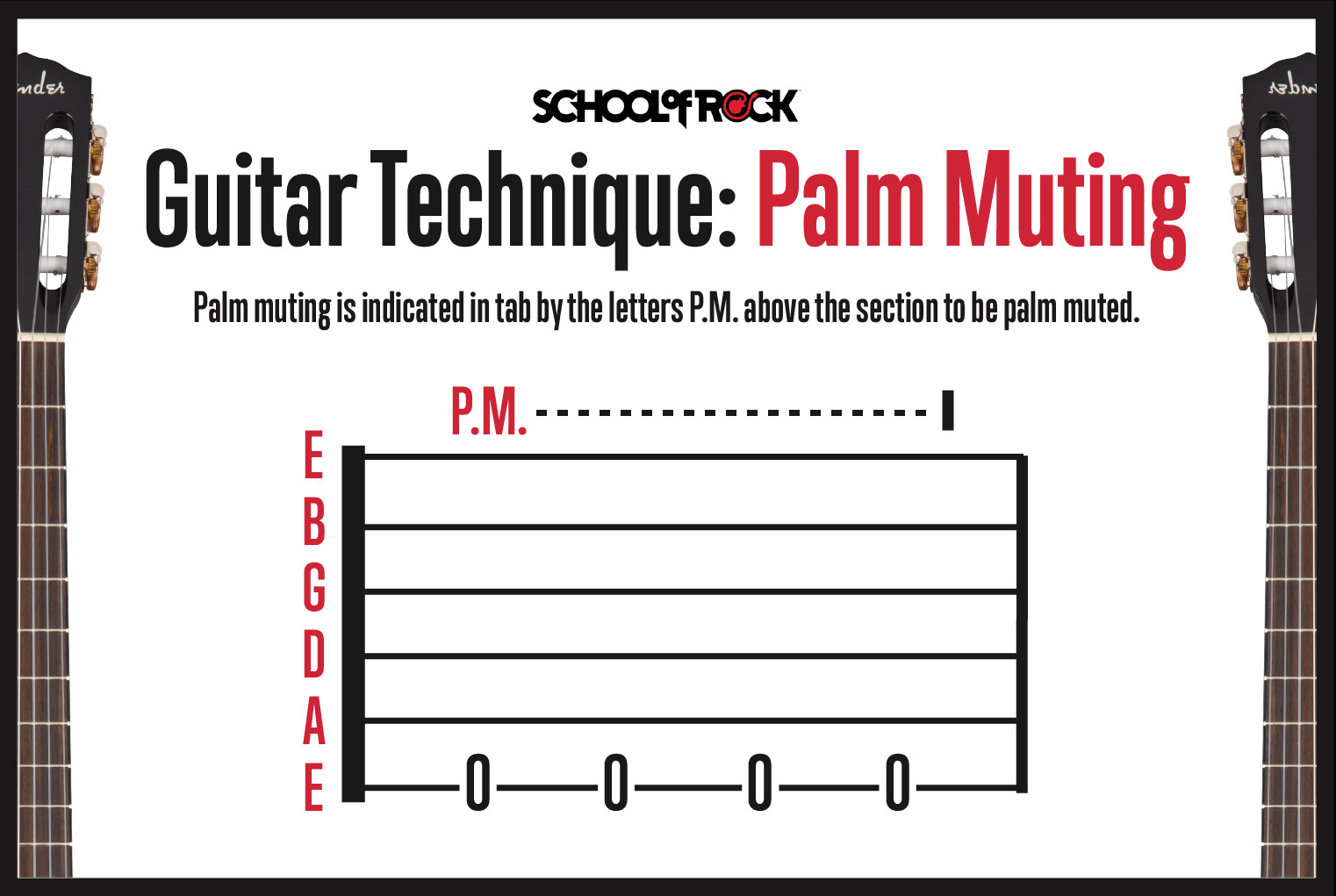 Guitar technique palm muting
Guitar technique palm muting
Visual example of palm muting technique in guitar tablature, indicated by “P.M.”
GUITAR TECHNIQUE: MUTED NOTES – Fretting Hand Control
Muted notes, distinct from palm muting, are created using the fretting hand. In this technique, you pick the string, but the fretting hand lightly touches the string without fully pressing it down to the fret. This produces a percussive, less defined note. In guitar tabs, muted notes are represented by an “X” in place of a fret number.
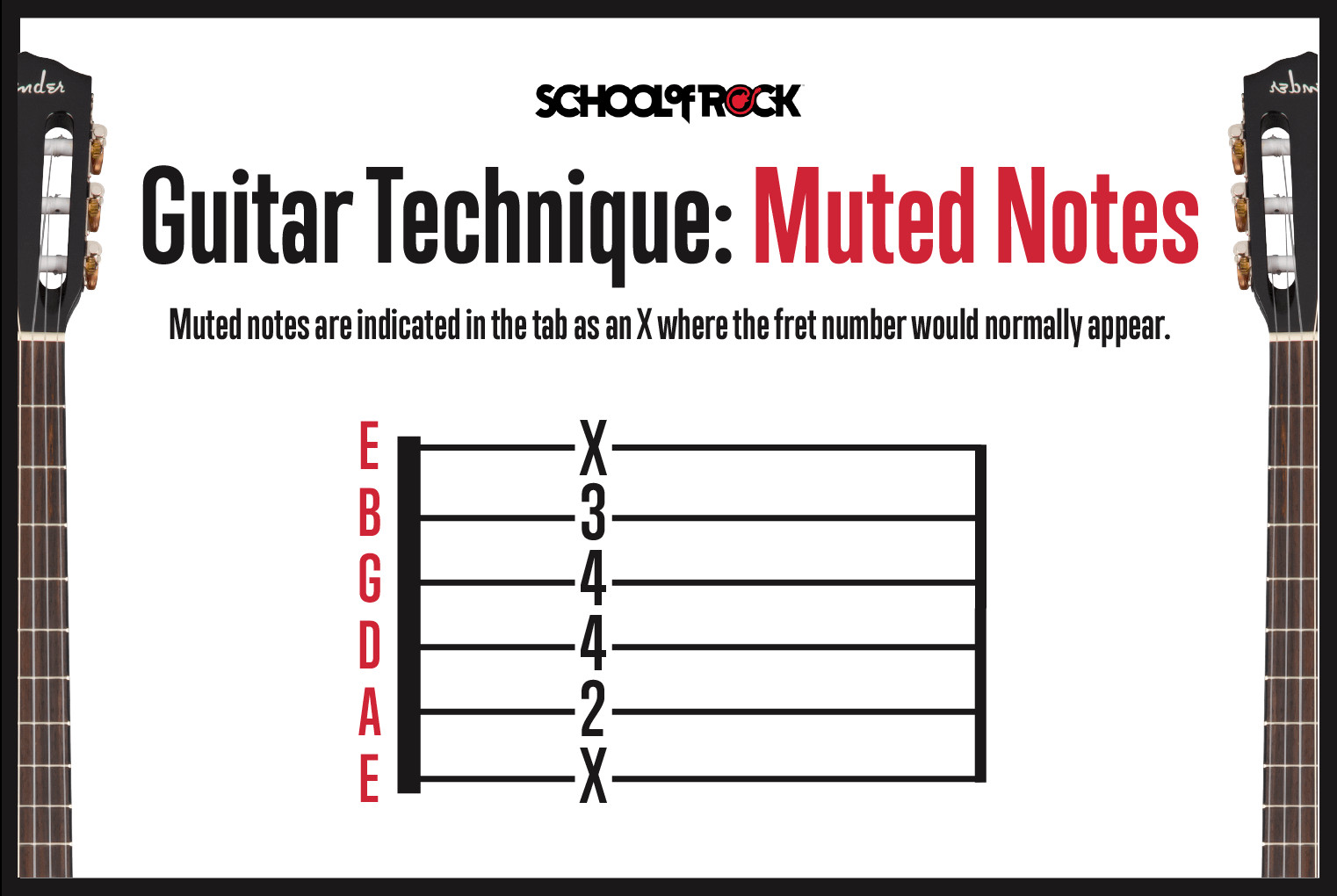 Guitar technique muted notes
Guitar technique muted notes
Muted notes in tablature are shown as ‘X’, indicating a percussive sound.
BENDING GUITAR STRINGS: Expressive Vocals on Guitar
String bending is a technique that adds a vocal-like expressiveness to guitar playing. Bends alter the pitch of a note by physically pushing or pulling the string across the fretboard. In guitar tabs, bends are indicated by a curved arrow above the note. The arrow often includes markings like “½” or “full,” indicating a half-step (one fret) or full-step (two frets) bend. The target pitch of the bend is often referred to as the “target note.”
HOW TO BEND STRINGS EFFECTIVELY
Bending involves pushing the string up or down the fretboard, not just pressing down vertically. For most strings (except the low E), you typically push upwards, towards the ceiling. The low E string is usually bent downwards, towards the floor. The key is to apply smooth, consistent pressure throughout the bend to achieve the desired pitch change.
GUITAR TECHNIQUE: BENDING – Strength and Control
Most bends are performed using a combination of fingers for strength and control. Typically, the ring finger is the primary fretting finger, with the middle and index fingers supporting it, adding strength and stability. This multi-finger approach makes bending smoother, easier to control, and helps in accurately reaching the intended pitch.
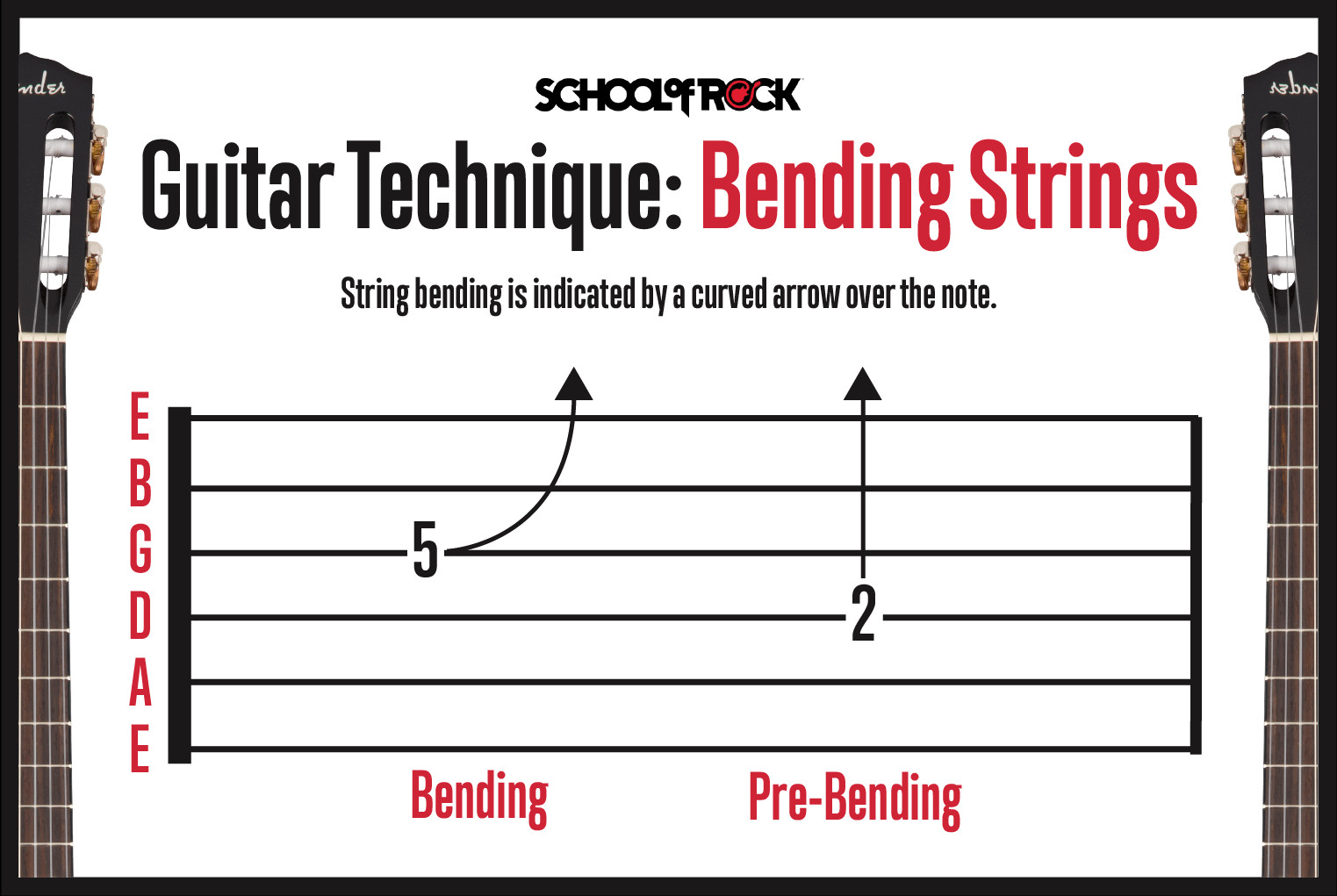 Guitar technique bending strings
Guitar technique bending strings
Tablature notation for string bending, showing curved arrow and bend direction.
GUITAR TECHNIQUE: PRE-BENDING – Surprise Pitch Release
Beginners learning how to read tabs on a guitar might encounter “pre-bends.” In a pre-bend, you bend the string to the target pitch before picking it, and then pick the pre-bent note, often releasing the bend to return to the original pitch. Pre-bends are shown in tabs with an upward arrow indicating the bend amount (full, ½, etc.), followed by a downward curved arrow indicating the release. Pre-bends can resolve back to the original note or bend further to a new target pitch.
SLIDING GUITAR NOTES: Seamless Transitions
Sliding is another expressive technique for smoothly moving between notes. Instead of lifting and re-picking, you maintain pressure on the fret and slide your finger up or down the fretboard to the next note.
GUITAR TECHNIQUE: SLIDE UP – Ascending Smoothness
In guitar tabs, a slide up to a higher note is represented by a line connecting the starting and ending notes, with the line often angled slightly upwards.
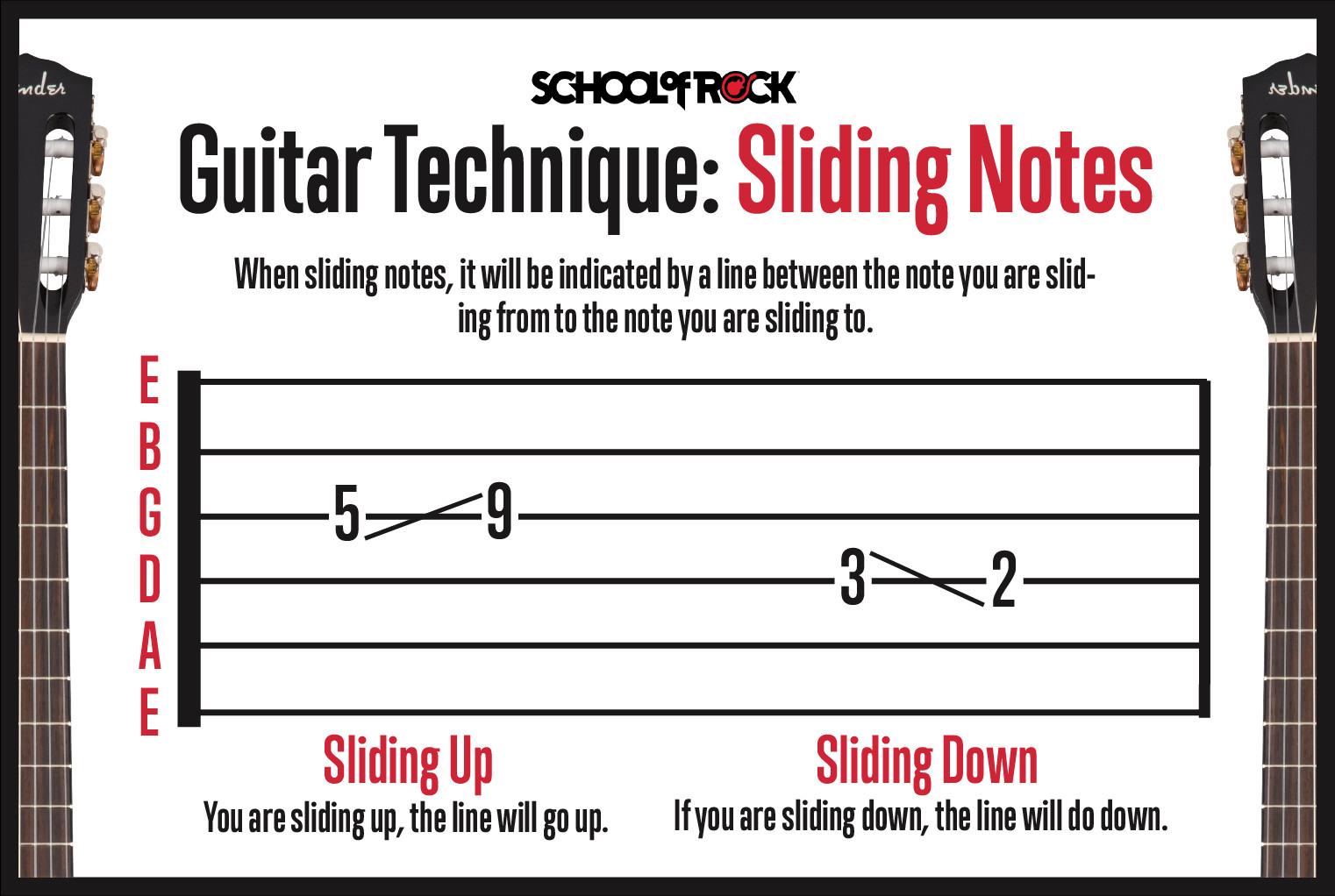 Guitar technique sliding notes
Guitar technique sliding notes
Tablature showing a slide up technique with an upward angled line.
GUITAR TECHNIQUE: SLIDE DOWN – Descending Grace
Conversely, a slide down to a lower note is also shown by a line between notes, but the line may be angled slightly downwards.
HAMMER-ONS ON THE GUITAR: Percussive Articulation
The hammer-on is a technique where you articulate a note not by picking, but by “hammering” your fretting finger onto the string. This can be from an open string or a previously fretted note, and the resulting note will be higher in pitch. In guitar tabs, hammer-ons are marked with an “H” and an arc connecting the initial note to the hammered-on note.
HOW TO EXECUTE HAMMER-ONS
To perform a hammer-on, strike the string onto the fret with enough force from your fretting finger to sound the note clearly without picking it. This requires practice to achieve a clean, strong tone. Electric guitars, especially at higher volumes, tend to make hammer-ons easier to execute. Start practicing with an open low E string and hammer-on at the third fret, letting the note ring. Repeat on different strings and frets to build technique.
 Guitar technique hammer ons
Guitar technique hammer ons
Hammer-on technique notation in tablature, marked with “H” and an arc.
PULL-OFFS ON THE GUITAR: The Reverse Hammer-On
Pull-offs are the opposite of hammer-ons. Instead of hammering on, you “pull off” a fretted finger to sound either an open string or a lower fretted note. Pull-offs are shown in guitar tabs with a “P” and an arc connecting the pulled-off note to the resulting lower note.
HOW TO MASTER PULL-OFFS
To execute a pull-off, fret a note, and then pull your finger off the string in a way that plucks the string, causing it to vibrate and sound a lower note (either open or fretted by another finger). When practicing pull-offs, ensure you “grab” enough of the string with your fingertip as you pull off to create a clear sound.
Hammer-ons and pull-offs can be combined in rapid alternation to create trills or legato passages, adding fluidity to your playing.
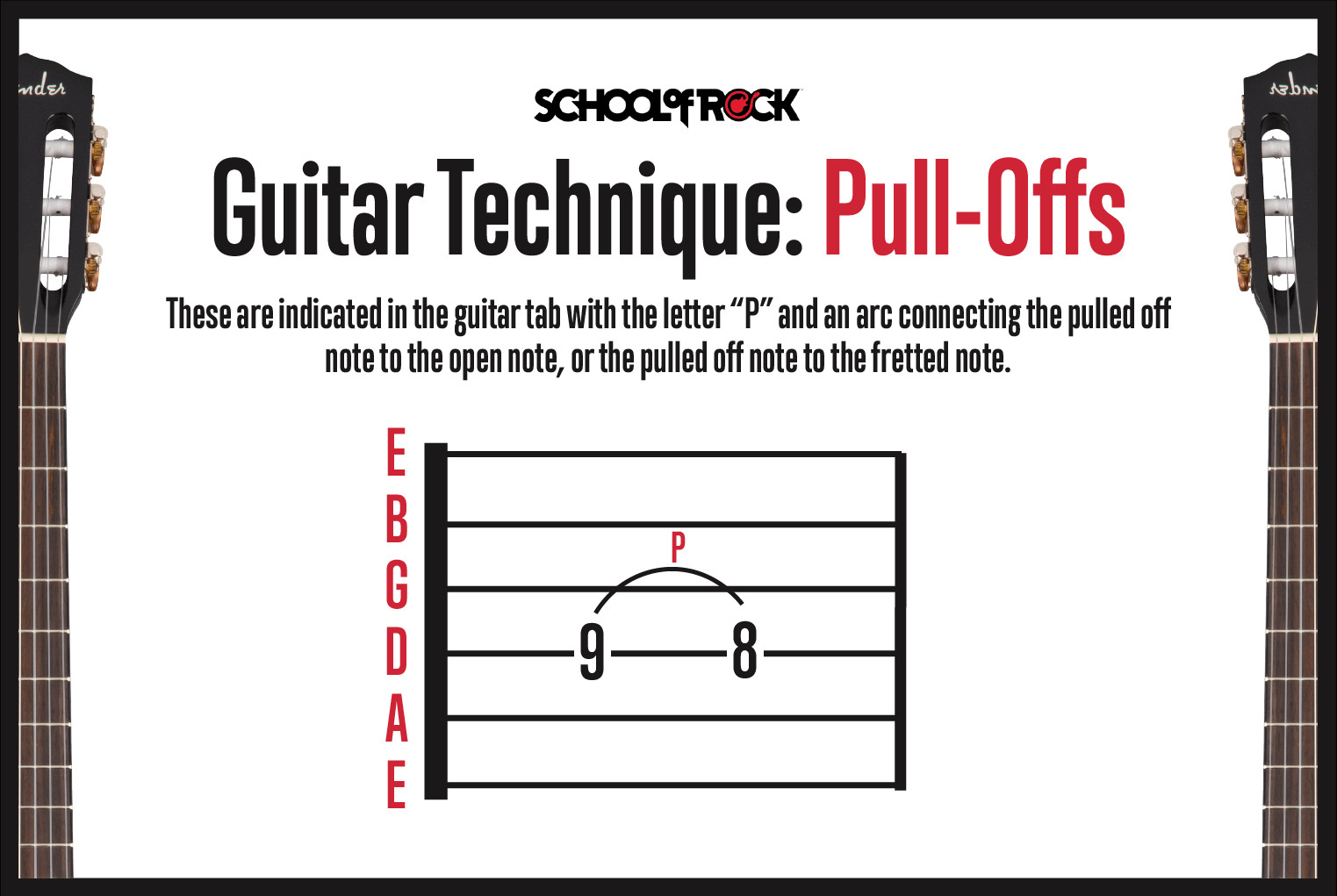 Guitar technique pull offs
Guitar technique pull offs
Pull-off technique notation in tablature, marked with “P” and an arc.
VIBRATO ON THE GUITAR: Adding Emotion
Vibrato is a technique that adds warmth and emotion to notes. It involves subtly and repeatedly bending a note and releasing it without fully lifting your finger from the string. This creates a wavering pitch effect. In guitar tabs, vibrato is indicated by a zig-zag line above the staff. The length of the zig-zag line often suggests the duration of the vibrato effect.
HOW TO CREATE VIBRATO
Vibrato is similar to bending but with smaller pitch variations. You can apply vibrato using a single finger or by supporting the main fretting finger with others. Start by practicing slow, smooth vibrato and gradually vary the speed for different expressive effects. Like bending, vibrato is a very personal technique; every guitarist develops a unique vibrato style.
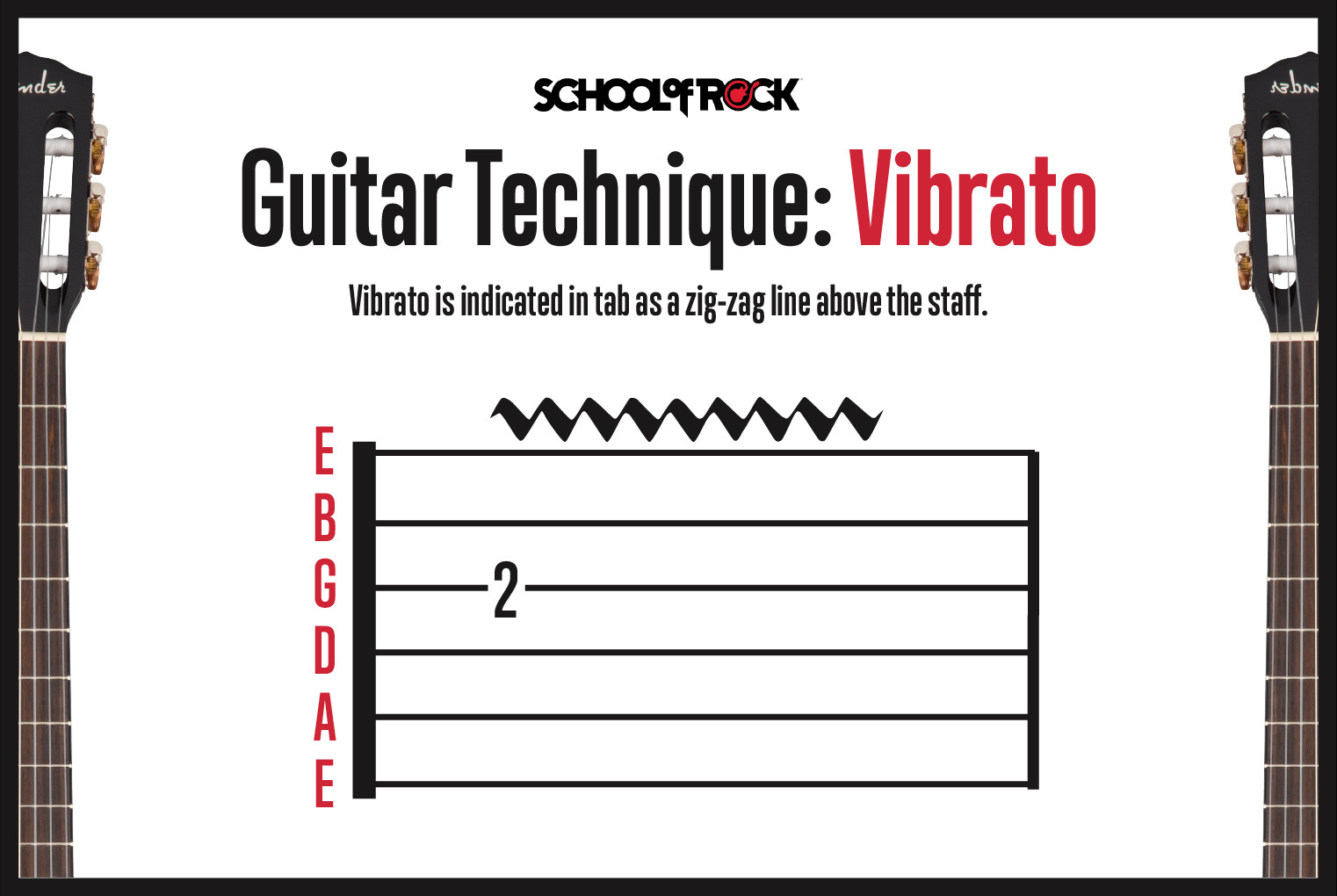 Guitar technique vibrato
Guitar technique vibrato
Vibrato technique notation in tablature, shown as a zig-zag line.
TAPPING GUITAR: Two-Handed Magic
Tapping is a technique that involves using both hands on the fretboard. Typically, you fret notes with your regular fretting hand while also “tapping” notes onto the fretboard with the index finger of your picking hand. The tapping motion is essentially a hammer-on performed by your picking hand. Tapping is notated in guitar tabs with a “T” above the tapped note.
HOW TO FINGER TAP
Tapping was popularized by Eddie Van Halen but has roots in classical guitar. To finger tap, fret a note with your fretting hand and then forcefully tap a higher fret on the same string with your picking hand’s index finger.
Tapping extends the range and speed of your playing, allowing for wide intervals and fast passages that are difficult to achieve with just one hand. Playing with distortion and higher volume often enhances the clarity and sustain of tapped notes.
 Guitar technique tapping notes
Guitar technique tapping notes
Tapping technique notation in tablature, marked with “T”.
GUITAR TECHNIQUE: TWO-HANDED TAPPING – Independent Lines
Two-handed tapping takes the technique further, with both hands independently tapping notes on the fretboard without traditional picking. This can involve the fretting hand tapping bass lines while the picking hand taps melody or solo lines, creating complex textures.
STRUMMING GUITAR NOTES: Rhythm and Groove
Strumming is essential for playing chords rhythmically. There are two primary strumming directions: downstrokes and upstrokes.
Downstrokes are played from the lower strings towards the higher strings in a downward motion. In guitar tabs, downstrokes are represented by a symbol resembling a thick horizontal line with two downward “legs.”
Upstrokes are the opposite, played from the higher strings to the lower strings with an upward motion. Upstrokes in tabs are notated with a “V” shaped symbol.
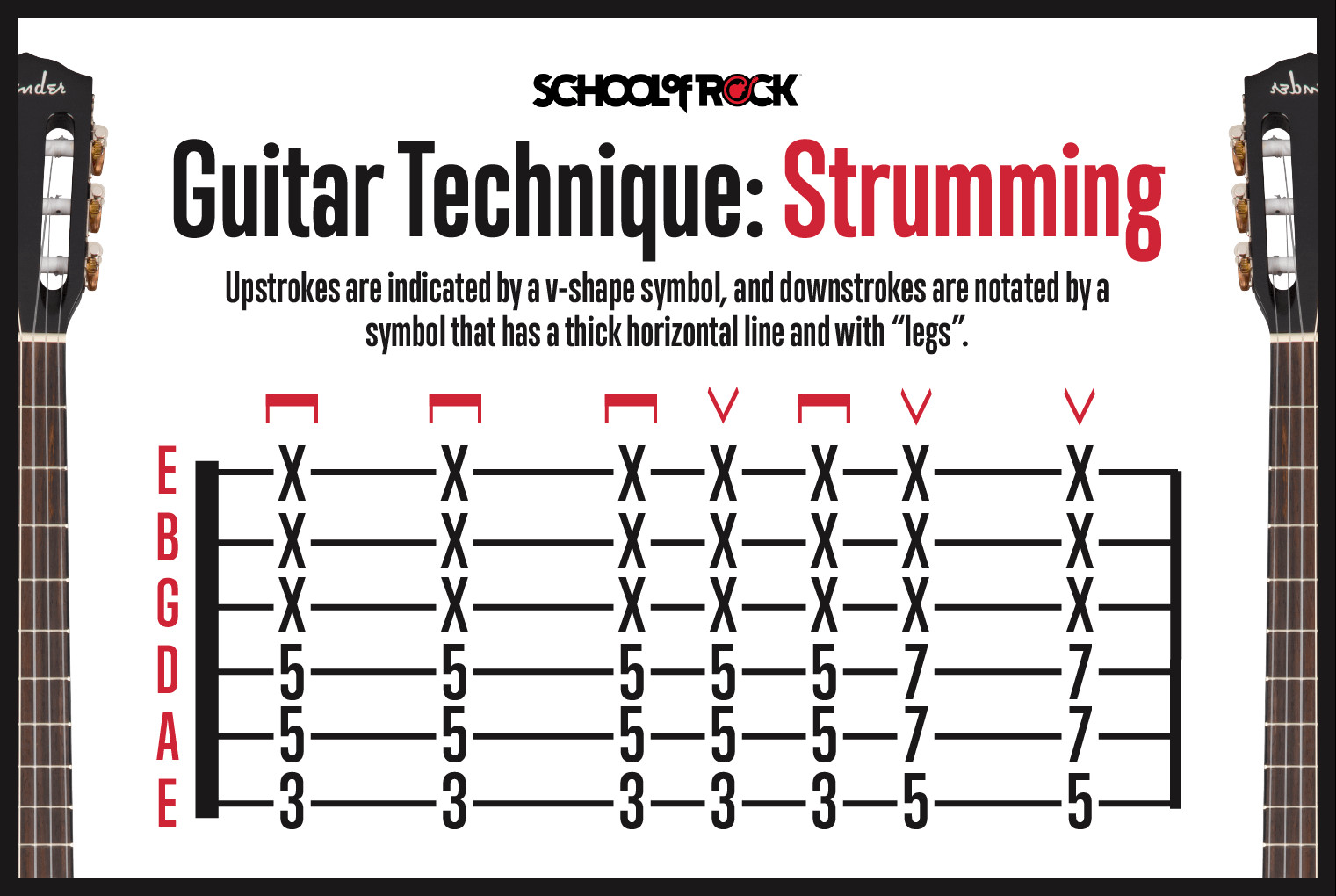 Guitar technique strumming
Guitar technique strumming
Strumming notation in tablature showing downstroke and upstroke symbols.
HOW TO STRUM EFFECTIVELY
Various strumming patterns are used depending on the song’s rhythm. You can use constant downstrokes, alternating up and downstrokes, or more complex combinations. For rhythms based on eighth notes (counted as “1 and 2 and 3 and 4 and”), many songs use alternating downstrokes on the numbered beats (1, 2, 3, 4) and upstrokes on the “ands.”
GUITAR TECHNIQUE: DOWNSTROKES AND UPSTROKES FOR SINGLE NOTES
The same downstroke and upstroke notation applies even when playing single notes in guitar tabs. Downstrokes (thick horizontal line with legs) indicate picking downwards, and upstrokes (“V”) indicate picking upwards. This notation can be crucial for achieving the intended rhythmic feel of certain riffs or melodies.
READY TO EXPLORE MORE GUITAR TECHNIQUES?
Now that you’ve learned how to read tabs for guitar and understand common guitar techniques, you’re well-equipped to start playing! From beginners to advanced players, guitarplayers.net is committed to guiding you on your musical journey. Our resources and expert guidance can help you quickly learn to play your favorite songs and techniques.
Ready to find guitar tabs? Whether you’re looking for easy beginner songs or challenging pieces, our resources have you covered. Explore our curated selections and start playing today!
Considering a new guitar? Check out our Guitar Buying Guide for helpful tips!

